For enthusiasts of rhythm action games, the mid-2010s marked an exciting resurgence with the return of iconic franchises like Guitar Hero and Rock Band. As someone deeply invested in the genre, the simultaneous launch of new titles in both series was a significant event. The intriguing aspect was how distinct each game aimed to be, promising different experiences for players.
However, for the average gamer, especially those looking to dive into the world of plastic guitars on their PlayStation 4, choosing between Guitar Hero Live and Rock Band 4 could be a crucial decision. If you’re pondering which game to invest in for your PS4 and guitar setup, this comprehensive comparison is designed to provide an unbiased and detailed perspective to guide your choice. Let’s get ready to rock and explore which game reigns supreme for your musical gaming needs.
Round 1: Backwards Compatibility with Your Guitar Gear
For players who have amassed a collection of plastic instruments from previous rhythm game eras, backwards compatibility is a significant factor. The ability to utilize existing equipment without incurring additional costs for new peripherals is a definite advantage.
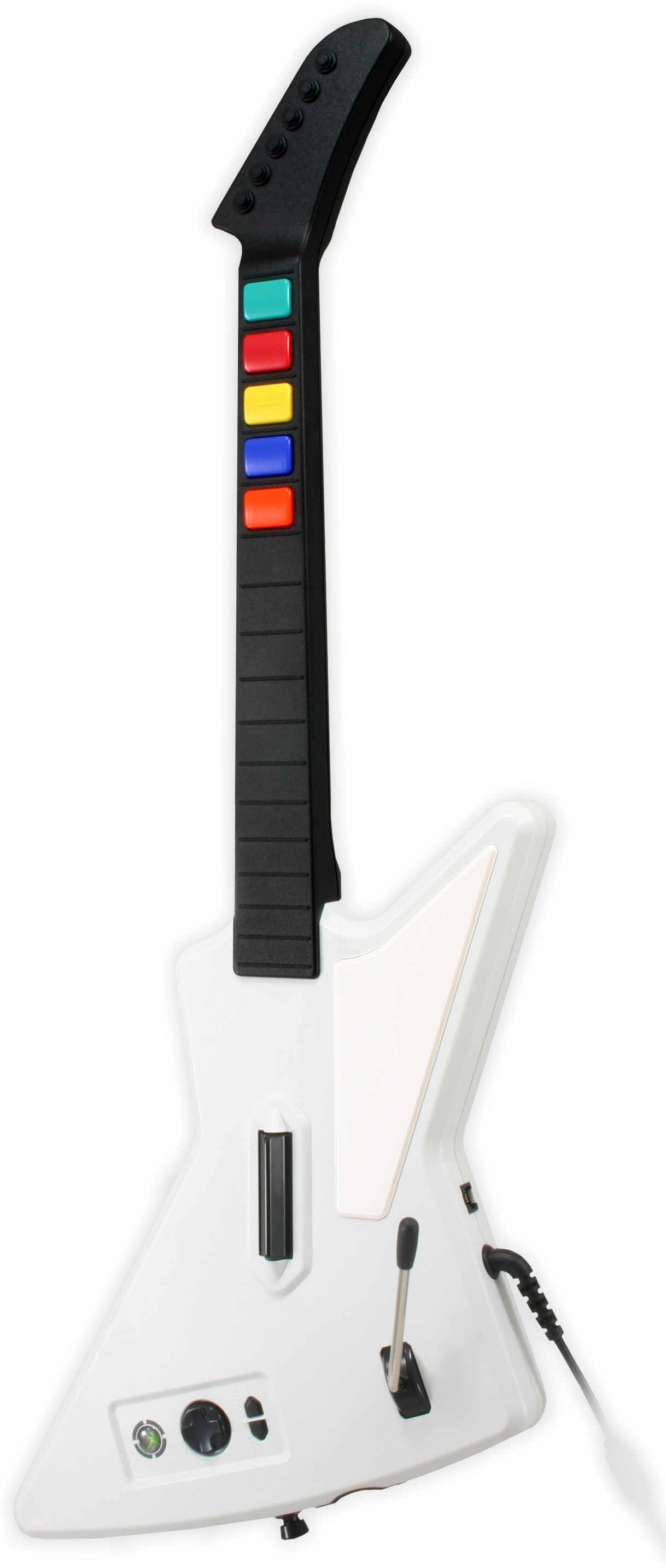 A classic Guitar Hero 2 controller representing older plastic instruments
A classic Guitar Hero 2 controller representing older plastic instruments
Rock Band 4 proudly champions backwards compatibility, and for the most part, it delivers. The PlayStation 4 version of Rock Band 4 is designed to work seamlessly with a wide array of legacy Rock Band and Guitar Hero wireless peripherals. This means your wireless guitar controllers from previous console generations should largely function without issue, offering a cost-effective entry point or a way to keep using your favorite plastic axes.
However, the compatibility isn’t absolute. Due to technical limitations and device authentication processes, wired controllers are not supported on Rock Band 4 for PS4. While most wireless, last-generation controllers are generally compatible, players heavily invested in specific wired controllers might find this a limitation.
In stark contrast, Guitar Hero Live adopts a completely different stance on instrument compatibility. The game introduces a redesigned guitar controller with a novel button layout, fundamentally altering the gameplay experience. This new button configuration renders older five-button guitar controllers incompatible with Guitar Hero Live. Therefore, if you opt for Guitar Hero Live, you will be required to adopt the new guitar and leave your previous instruments behind.
Winner: Rock Band 4
Round 2: Guitar Gameplay and Feel on PS4
Guitar gameplay remains the heart of rhythm games, even with the expansion to drums, vocals, and other instruments in some franchises. For many, the guitar controller is the primary instrument and the core experience.
Rock Band 4 on PS4 retains the classic five-color fret button system that has become synonymous with the genre. If you are familiar with prior Guitar Hero or Rock Band titles, you’ll instantly feel at home with Rock Band 4‘s guitar gameplay. The core mechanics are largely unchanged, providing a comfortable and familiar experience for veteran players.
 Gameplay screen of Rock Band 4 on PS4 showcasing the note highway
Gameplay screen of Rock Band 4 on PS4 showcasing the note highway
A notable addition to Rock Band 4 is the freestyle guitar solo sections. During these segments, players can improvise and play virtually any notes, with the game intelligently weaving them into a coherent and musical solo. While these freestyle solos offer a degree of creative freedom, their implementation can sometimes feel a bit disjointed or out of place within the song structure. However, the option to disable freestyle solos is available for purists who prefer traditional note-for-note guitar gameplay.
Guitar Hero Live, on the other hand, represents a revolutionary departure from established norms. It abandons the five-color button system entirely, introducing a brand-new guitar controller with two rows of three buttons. This innovative design aims to emulate the feel of playing a real guitar more closely.
The new six-button layout in Guitar Hero Live offers a different and arguably more engaging guitar playing experience. On higher difficulty settings, players are challenged with complex chord shapes that span both rows of buttons. Successfully executing these chords provides a more tactile and rewarding sensation, enhancing the sense of musical achievement as muscle memory develops.
The innovative guitar controller in Guitar Hero Live was developed by Freestyle Games, renowned for their work on DJ Hero. Their expertise in crafting unique peripherals shines through in the Guitar Hero Live guitar, which, after an initial adjustment period, can feel like a genuine evolution of the genre’s guitar gameplay. In terms of pure guitar playing feel and innovation, Guitar Hero Live edges out Rock Band 4.
Winner: Guitar Hero Live
Round 3: Instruments Beyond the Guitar in Rhythm Games
This category highlights a fundamental difference in design philosophy between the two games. Rock Band has always been about the band experience, while Guitar Hero Live takes a more focused approach.
Rock Band 4 stays true to its band-centric roots, offering a full ensemble experience. Drums, bass guitar, and vocals are all integral components of the Rock Band 4 experience on PS4. Similar to guitar controllers, most wireless legacy controllers for these instruments are compatible, allowing for a full band setup using existing peripherals.
Regrettably, Rock Band 4 omits support for keyboards, an instrument that had shown promise in previous iterations but is absent in this version. This means Rock Band 3 keyboard controllers will not function with Rock Band 4, limiting the instrumental options compared to its predecessor.
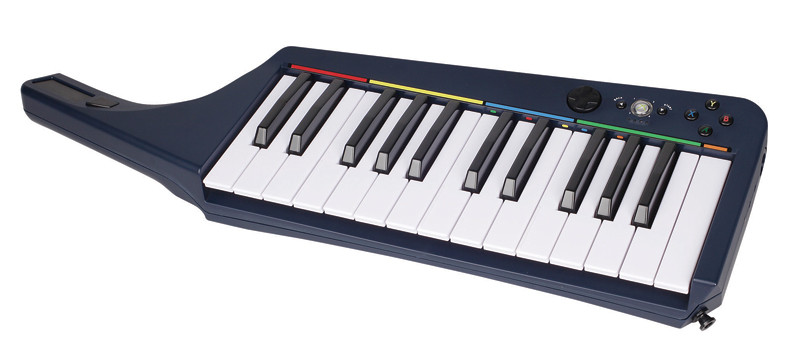 A Rock Band 3 keyboard controller representing instruments not supported in Guitar Hero Live
A Rock Band 3 keyboard controller representing instruments not supported in Guitar Hero Live
Conversely, Guitar Hero Live narrows its focus exclusively to the guitar experience. The game is designed around the lead guitar role, eliminating drums and bass guitar entirely from the gameplay. While vocals are supported via a microphone or a companion app, the core gameplay of Guitar Hero Live is centered solely on mastering the guitar. Other instruments are simply not part of the equation.
Winner: Rock Band 4
Round 4: Visual Design and Presentation on PS4
Visual aesthetics are subjective, but the distinct art styles of Rock Band 4 and Guitar Hero Live contribute significantly to their overall appeal and player immersion.
Rock Band 4 maintains a visual continuity with its predecessors. While offering expected graphical enhancements, the overall visual style remains largely consistent with earlier Rock Band games. Character creation and band customization are still present, utilizing the familiar stylized polygonal characters that long-time Rock Band players will recognize.
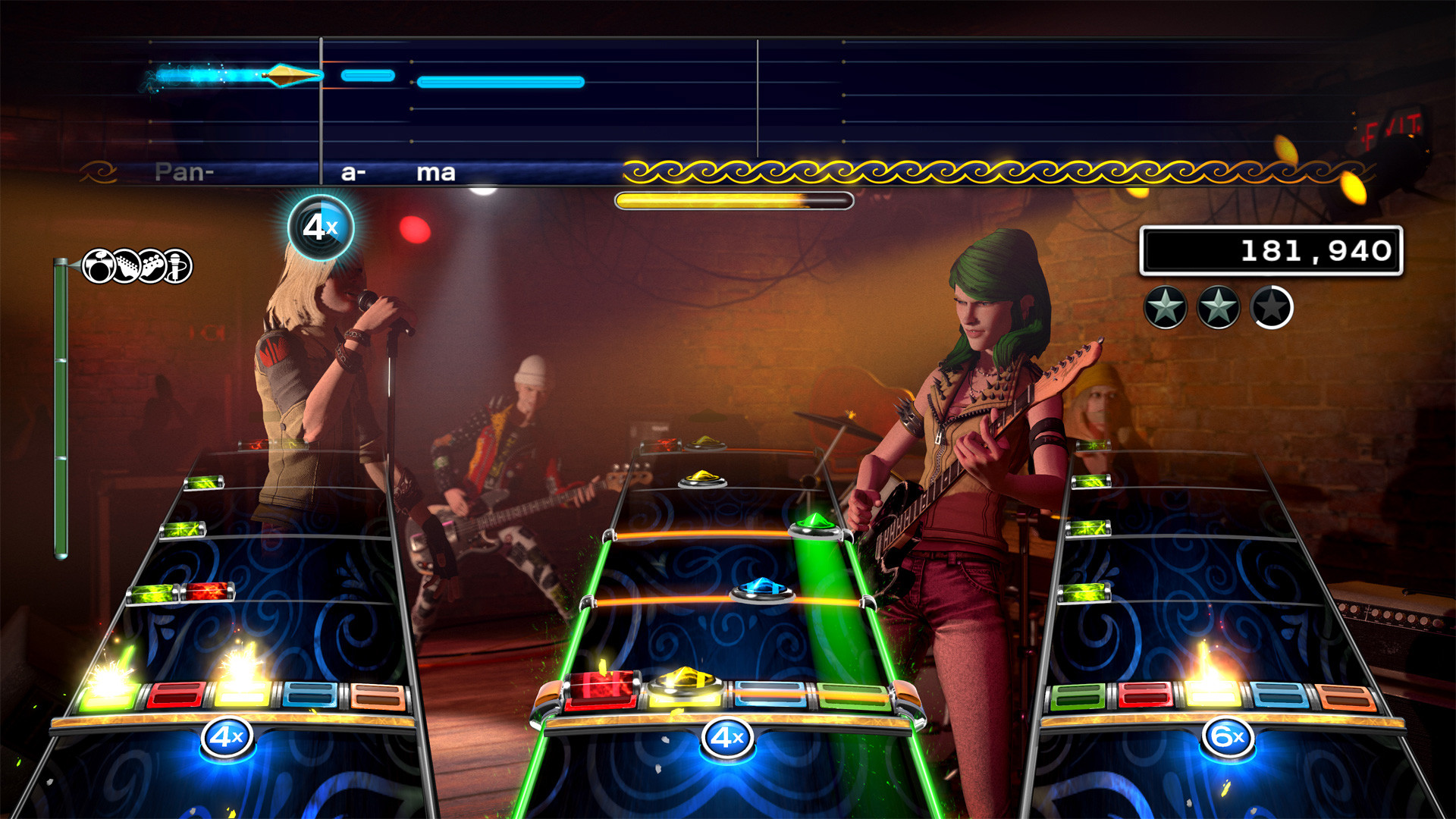 A band performing in Rock Band 4, showcasing the familiar visual style
A band performing in Rock Band 4, showcasing the familiar visual style
This consistent visual engine in Rock Band 4 is designed to accommodate a vast library of downloadable content seamlessly. DLC songs integrate smoothly into the game’s visual framework, with character animations and lip-syncing adapting well to diverse musical styles.
Guitar Hero Live adopts a radical visual departure, heavily emphasizing full-motion video in its presentation. This approach is implemented in two distinct game modes: GHTV and GH Live, with varying degrees of success.
The GHTV mode in Guitar Hero Live utilizes official music videos as the visual backdrop for gameplay. This creates a streaming music channel experience, where players perform along to actual music videos. This can be an engaging way to discover new artists and songs, enhancing the music discovery aspect of the rhythm game genre.
The GH Live mode in Guitar Hero Live presents live concert performances from a first-person perspective. The game dynamically switches between “good” and “bad” performance videos based on player accuracy, creating a reactive concert experience.
While technically impressive, the GH Live mode can feel somewhat artificial. The transitions between performance videos can be abrupt, and the acting within the live performance sequences can be perceived as overly dramatic or even cringeworthy. Furthermore, the idealized and uniformly attractive band members and crowds in GH Live can detract from the sense of realism and immersion for some players.
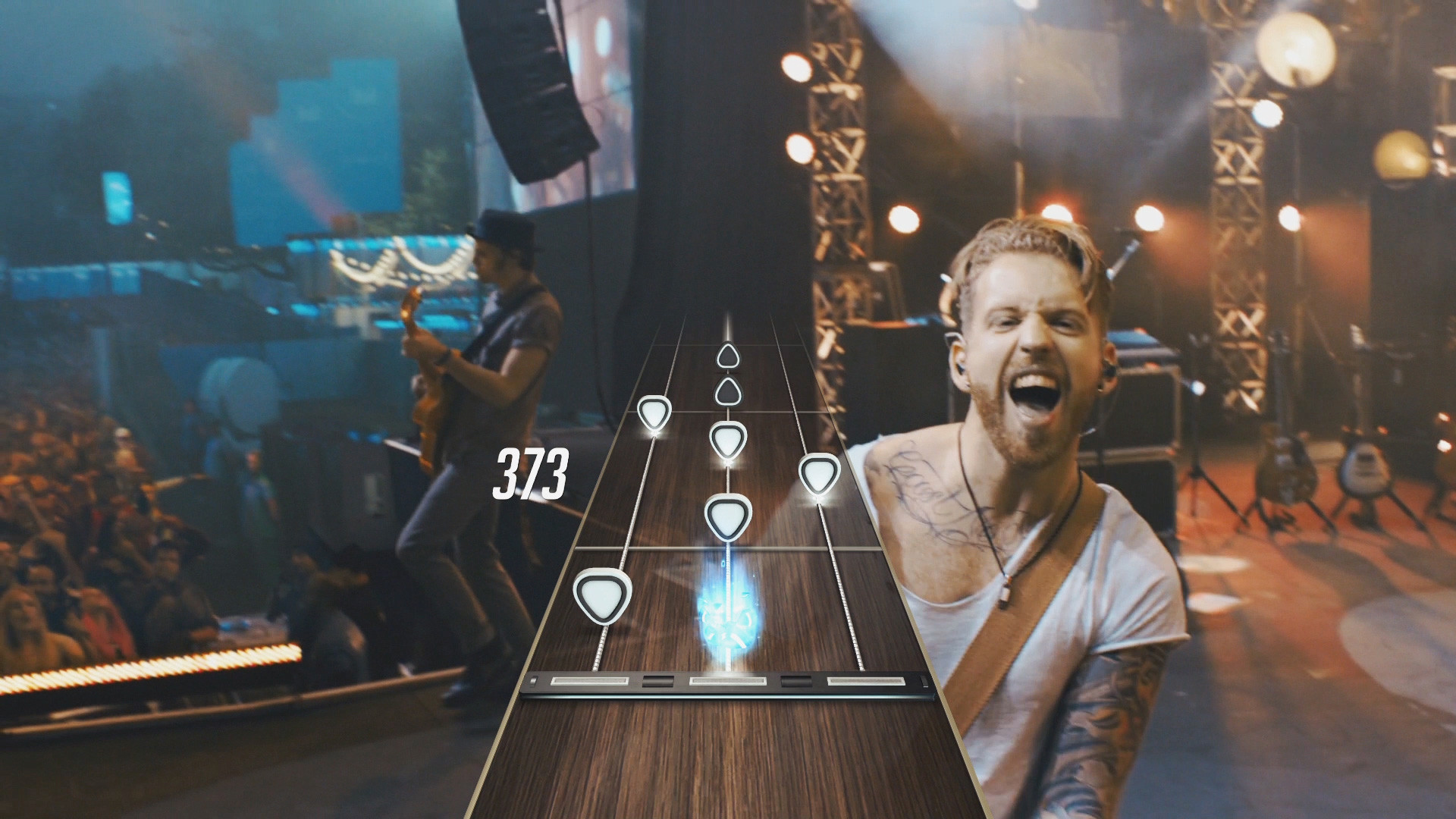 A scene from Guitar Hero Live's GH Live mode featuring live-action band members
A scene from Guitar Hero Live's GH Live mode featuring live-action band members
Despite the shortcomings of the GH Live mode, the GHTV mode’s integration of music videos provides a compelling and visually engaging experience. Ultimately, Guitar Hero Live‘s visual presentation, particularly through GHTV, offers a more distinct and modern aesthetic compared to Rock Band 4‘s more traditional approach.
Winner: Guitar Hero Live
Round 5: On-Disc and Free Content at Launch
For players mindful of upfront costs and immediate content availability, the amount of on-disc songs and readily accessible free content is a key consideration.
Rock Band 4 includes a substantial on-disc library of 65 songs, spanning a wide range of genres and eras, from classic tracks to contemporary hits. However, expanding this initial song selection within Rock Band 4 primarily relies on purchasing downloadable content (DLC). While occasional free songs may appear in the online store, they are relatively infrequent. Even importing songs from previous Rock Band games, like Rock Band 3, requires a purchase to unlock the import functionality.
Guitar Hero Live offers a more modest 42 songs within its GH Live concert mode. However, the GHTV mode launched with an impressive library of approximately 200 playable music videos available for streaming at no additional cost. Furthermore, this GHTV library has been consistently expanded with over 90 new songs added in the months following the game’s release, providing a continuous influx of fresh, free content.
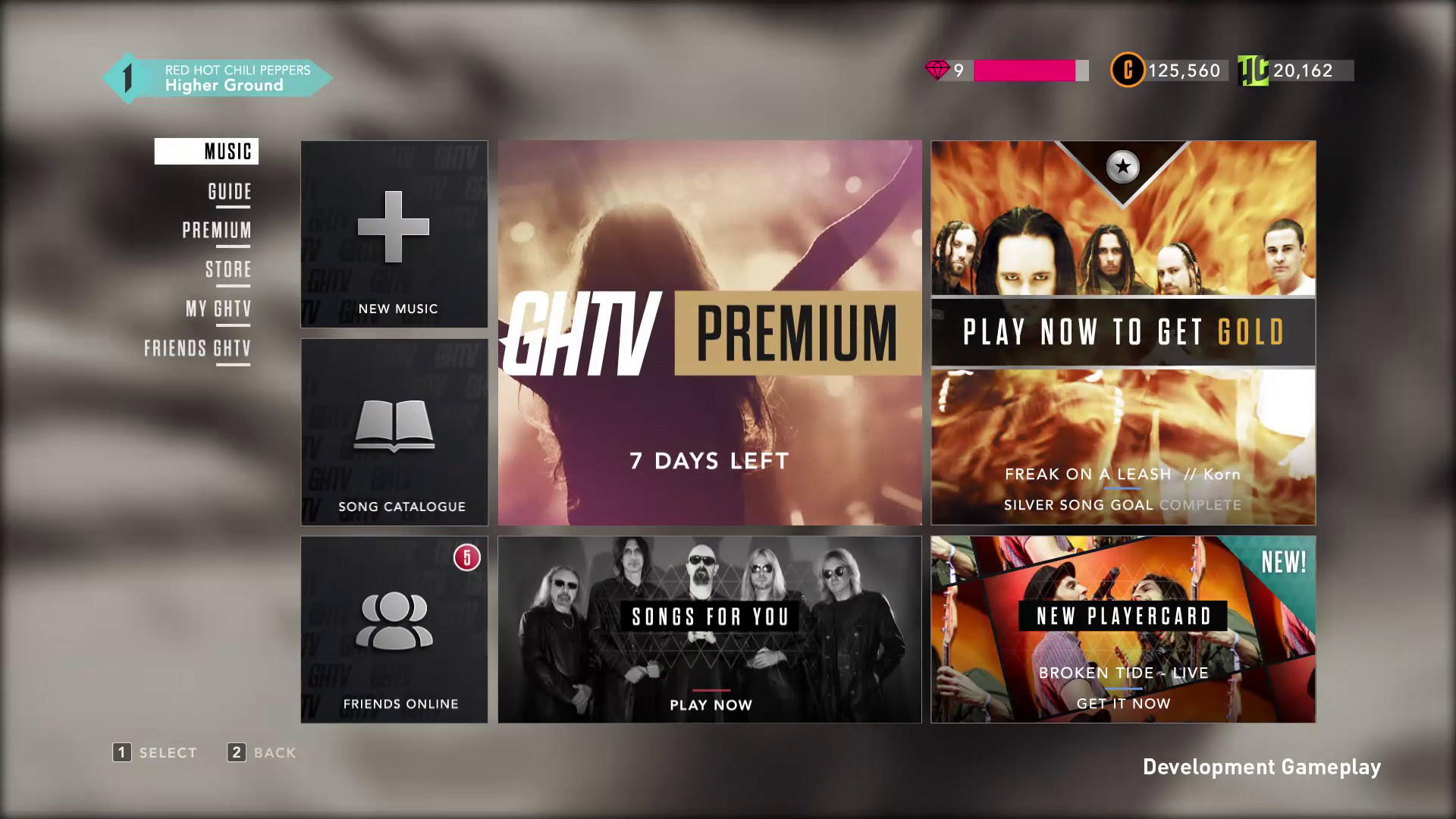 The GHTV mode interface in Guitar Hero Live, highlighting the streaming music video channels
The GHTV mode interface in Guitar Hero Live, highlighting the streaming music video channels
While GHTV’s streaming nature means players don’t have immediate on-demand access to every song in the library, “Play Tokens” can be earned through gameplay or purchased to enable on-demand song selection. For players prioritizing a large initial library and a continuous stream of new content without additional purchases, Guitar Hero Live provides a more generous offering than Rock Band 4 at the point of entry.
Winner: Guitar Hero Live
Round 6: Downloadable Content and Song Library Expansion
For players willing to invest in expanding their song libraries with downloadable content, the DLC offerings and purchasing models of Rock Band 4 and Guitar Hero Live differ significantly.
Guitar Hero Live‘s GHTV mode, despite its vast library, does not offer true song ownership. While players can access a wide array of songs, playing specific songs on demand requires using Play Tokens. Running out of tokens necessitates either earning more through gameplay or purchasing them with real currency. This token-based system can be restrictive for players who prefer to repeatedly play specific favorite songs.
Furthermore, the full-motion video production of the GH Live mode, with its bespoke live performance videos for each song, makes adding new DLC songs to this mode economically challenging. Consequently, the initial setlist of 42 songs in GH Live is unlikely to be expanded with further paid DLC.
Rock Band 4 adopts a more traditional DLC model. Its engine is designed for easy integration of new songs, and it has extensively leveraged this capability. A significant portion of the Rock Band 3 DLC catalog, comprising over 1500 songs, has been ported to Rock Band 4 and is available for purchase.
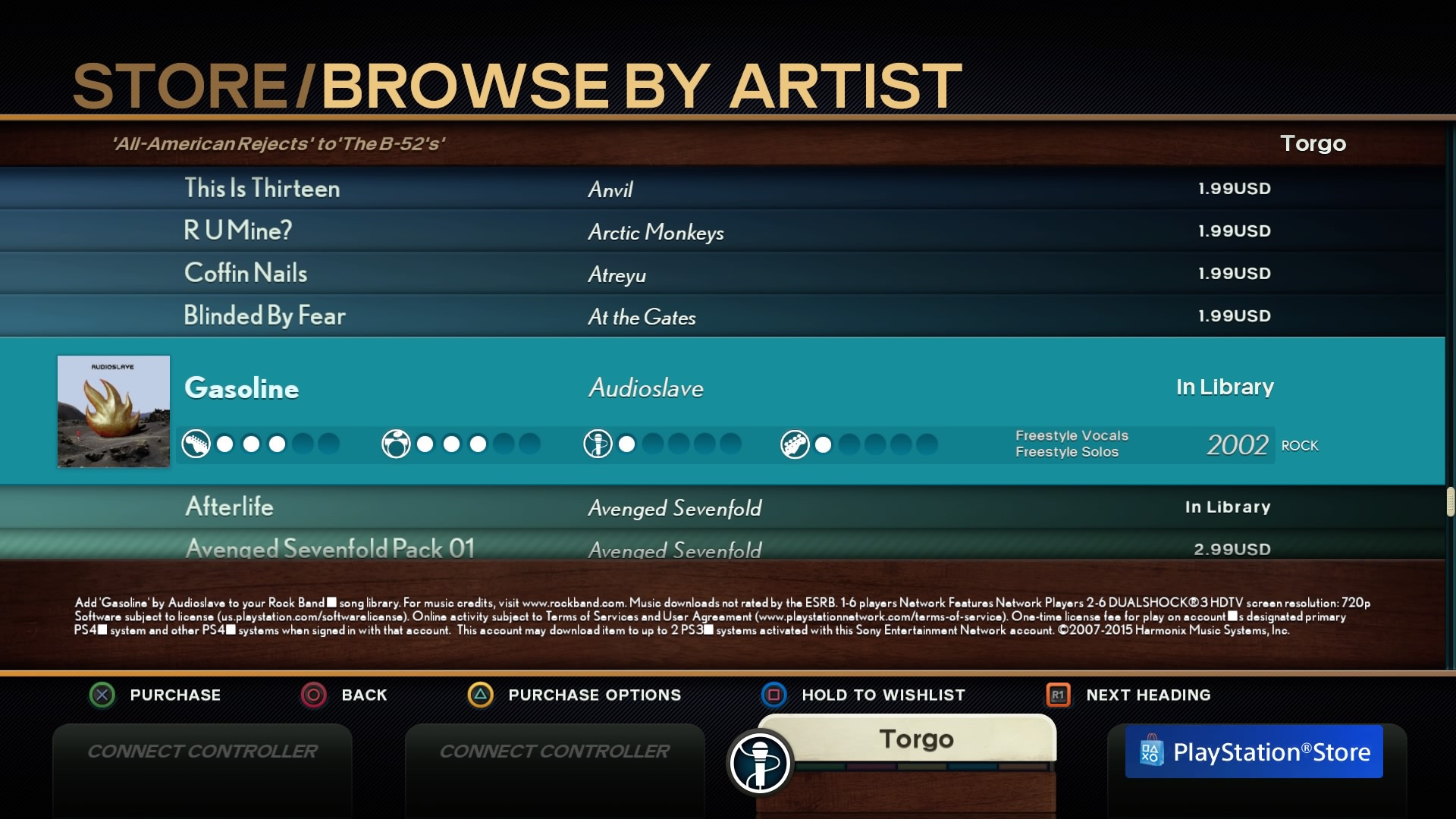 Rock Band 4 DLC store showcasing available song packs and artists
Rock Band 4 DLC store showcasing available song packs and artists
Crucially, purchasing a song in Rock Band 4 grants permanent ownership. Players can play purchased DLC songs as often as they wish without further restrictions. For players intending to build a substantial and permanently owned song library through DLC purchases, Rock Band 4 offers a far more robust and appealing platform.
Winner: Rock Band 4
Round 7: Single-Player Gameplay and Progression
The single-player experience varies significantly between rhythm games. For solo players, engaging progression systems and compelling single-player modes are essential.
Guitar Hero Live, with its singular focus on guitar gameplay and first-person perspective, is clearly designed with single-player engagement in mind. The GHTV mode incorporates a profile-based progression system where players earn experience points and level up by playing songs. Leveling up unlocks various cosmetic rewards, such as highway styles and profile icons, providing a sense of progression and customization.
Each song in GHTV also features specific challenges, adding replay value for solo players seeking to maximize their scores and complete objectives. While these challenges are relatively straightforward, they offer additional goals beyond simply playing through songs.
Rock Band 4‘s single-player offerings are less extensive. The Career mode in Rock Band 4 is notably shorter than its predecessor, Rock Band 3. Beyond the Career mode, single players primarily engage with Quick Play mode, which allows for playing individual songs. Rock Band 4 lacks a robust single-player progression system comparable to GHTV’s level-based rewards. For solo players seeking a sense of progression and long-term engagement, Guitar Hero Live provides a more compelling single-player experience.
Winner: Guitar Hero Live
Round 8: Local Multiplayer and Social Gameplay
For many rhythm game enthusiasts, the social aspect of playing with friends and family in local multiplayer is a core part of the genre’s appeal.
Guitar Hero Live significantly underperforms in local multiplayer. The game only supports a second guitar player in the GHTV mode, and both players perform the same guitar part. This results in a competitive, score-based multiplayer experience rather than a cooperative band dynamic. Given the inherent skill disparities often present in local multiplayer settings, this competitive approach can detract from the social enjoyment.
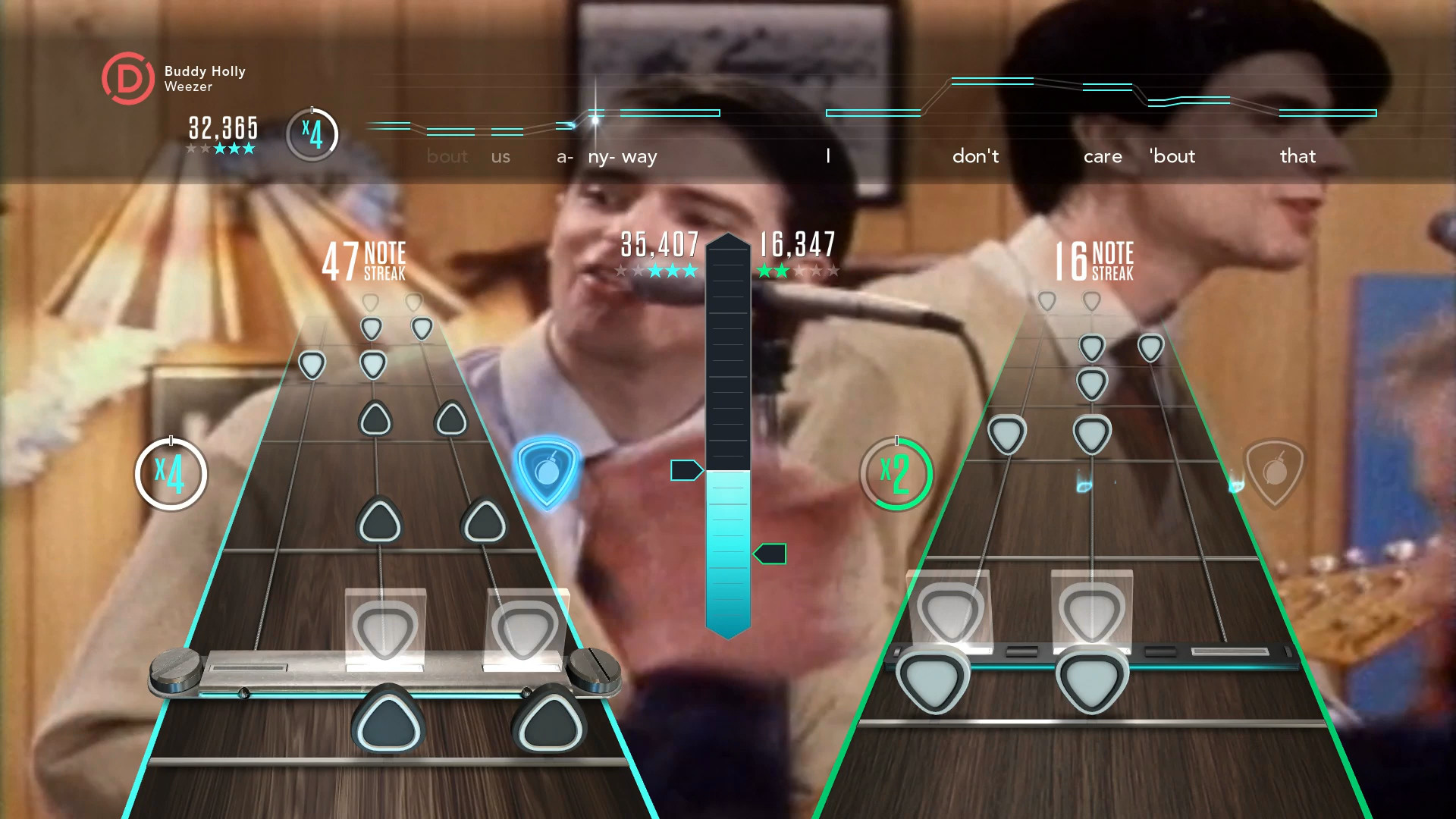 Two players attempting local multiplayer in Guitar Hero Live, highlighting its limitations
Two players attempting local multiplayer in Guitar Hero Live, highlighting its limitations
Conversely, Rock Band 4 excels as a local multiplayer experience. It retains and refines the cooperative band gameplay that defined previous Rock Band titles. Up to four players can perform together locally, playing guitar, bass, drums, and vocals in a band setting. The cooperative nature of Rock Band 4‘s multiplayer, where players synchronize to achieve high scores and band multipliers, fosters a strong sense of social engagement and shared musical enjoyment. Rock Band has long been recognized for its exceptional local multiplayer, and Rock Band 4 maintains this strength. For players prioritizing local multiplayer sessions with friends and family on PS4, Rock Band 4 is the superior choice.
Winner: Rock Band 4
Round 9: Ongoing Updates and Post-Launch Support
In the modern gaming landscape, ongoing updates and post-launch support are crucial for long-term game value. Both Rock Band 4 and Guitar Hero Live have demonstrated commitment to continued updates and content additions.
Rock Band 4 has received updates introducing social score challenge features, character customization options, and gameplay enhancements like the Brutal Mode, which dynamically increases difficulty based on player performance.
Guitar Hero Live has consistently expanded its GHTV library with new songs (over 90 added since launch) and introduced customization options like themed note highways. It also added an online multiplayer mode where players are matched against similarly skilled opponents in GHTV for competitive scoring and rewards.
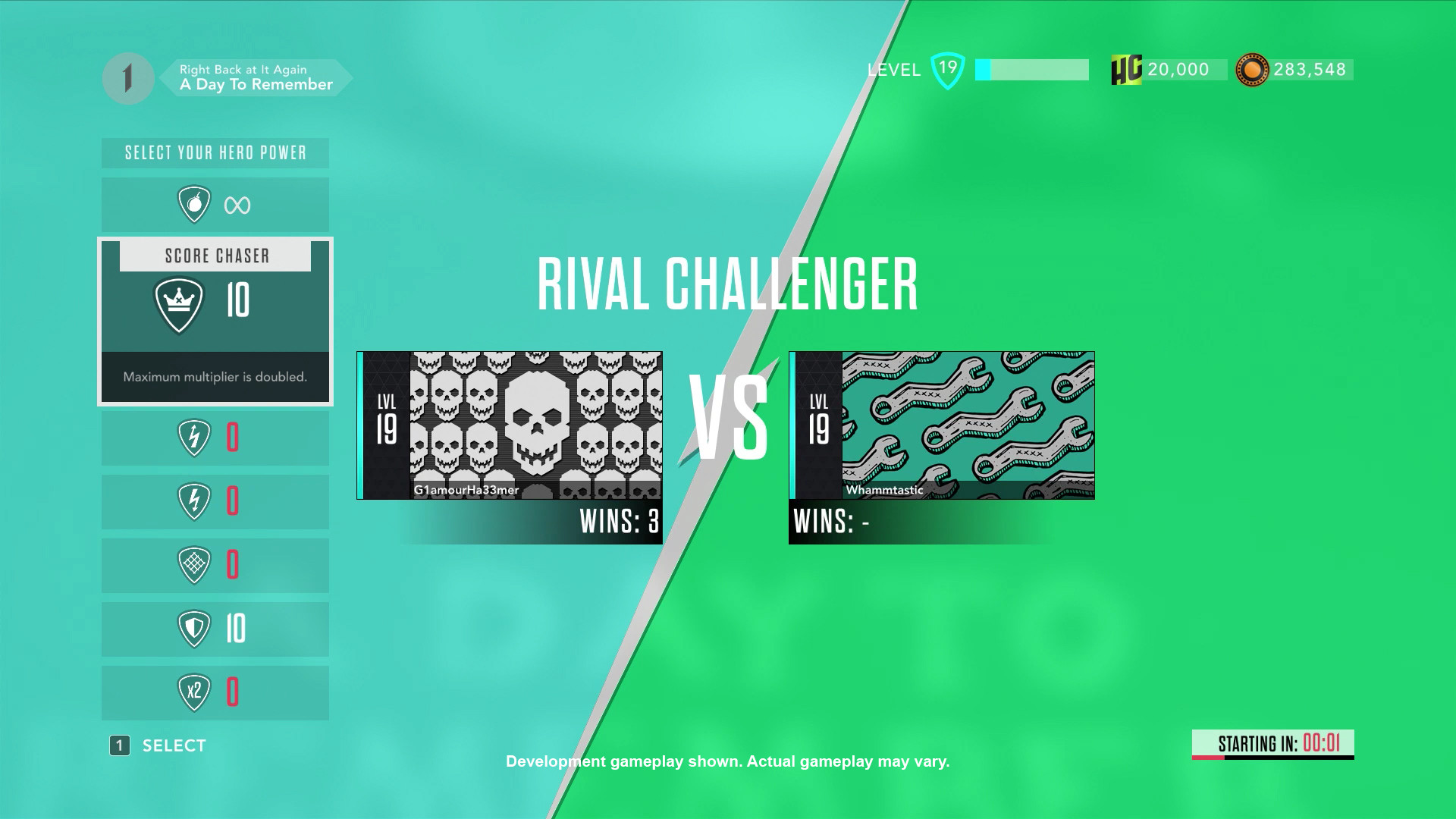 Guitar Hero Live Rivals mode interface, indicating online multiplayer features
Guitar Hero Live Rivals mode interface, indicating online multiplayer features
Both games have shown a dedication to ongoing support, providing new content, features, and customization options beyond their initial releases. This commitment suggests that both Rock Band 4 and Guitar Hero Live will continue to evolve and offer fresh experiences over time.
Winner: Draw
The Verdict: Choosing Your PS4 Guitar Game
Ultimately, the choice between Guitar Hero Live and Rock Band 4 for your PS4 rhythm game experience hinges on your individual preferences and gaming priorities.
If you are primarily a single-player gamer seeking a fresh and innovative guitar gameplay experience with a constantly expanding library of streamable songs, Guitar Hero Live is a compelling option. Its GHTV mode and unique guitar controller offer a distinct and modern take on the rhythm game genre.
 A scene from Guitar Hero Live emphasizing its modern and distinct visual style
A scene from Guitar Hero Live emphasizing its modern and distinct visual style
However, if you value local multiplayer and social band gameplay above all else, and desire a vast, permanently ownable DLC library, Rock Band 4 is the definitive choice. Its robust multiplayer, backwards compatibility, and extensive DLC support cater to players who enjoy playing with friends and building a substantial song collection.
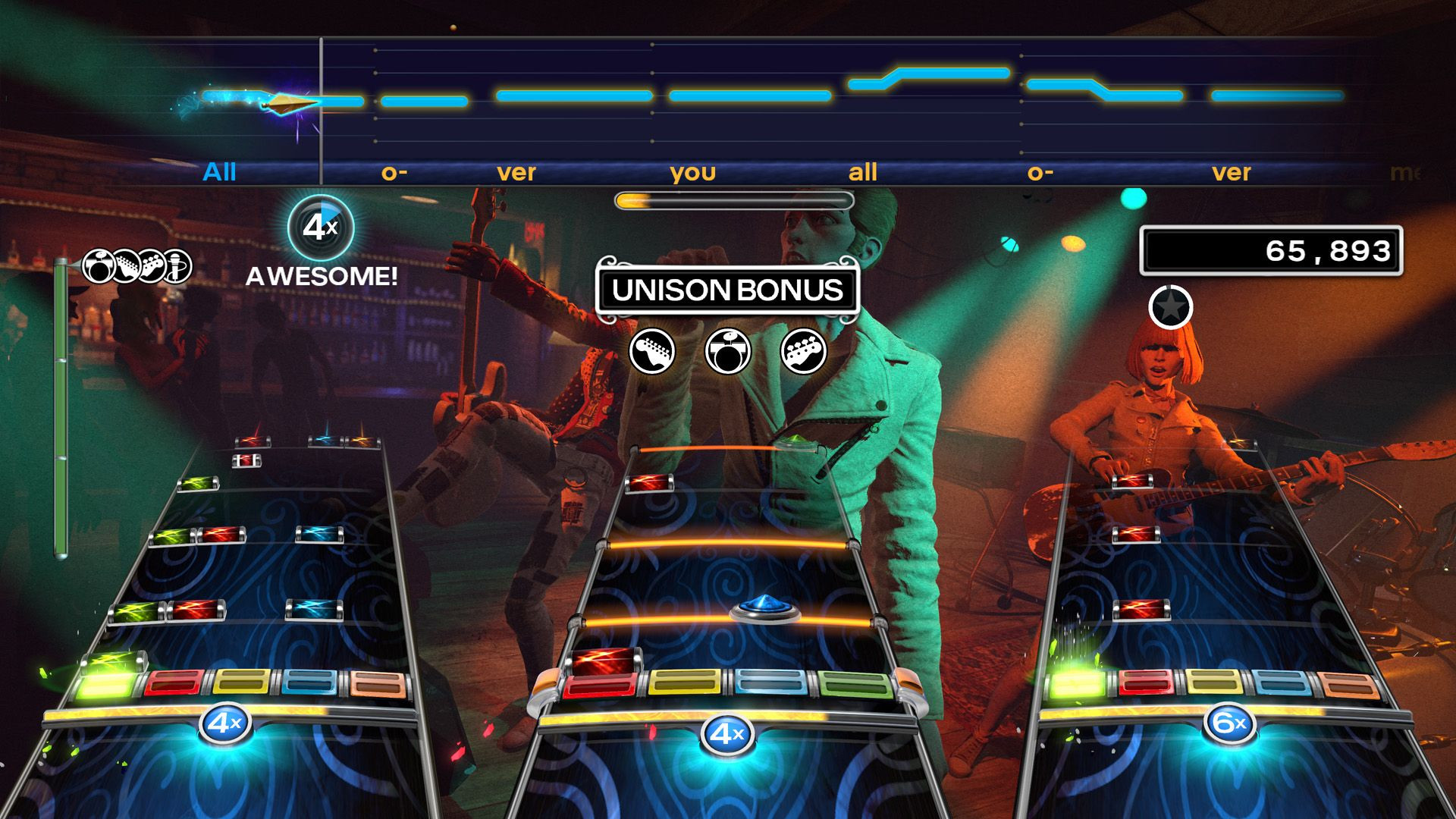 A band performing in Rock Band 4, highlighting its strengths in multiplayer and social gameplay
A band performing in Rock Band 4, highlighting its strengths in multiplayer and social gameplay
Price is also a factor. At launch, Guitar Hero Live was often more affordable when purchasing a guitar bundle, while Rock Band 4 could be more expensive, especially for the full band bundle. However, Rock Band 4 offered a lower entry point for players utilizing existing instruments. Current pricing may vary, so it’s advisable to check current retail prices for both games and instrument bundles on platforms like Amazon or the PlayStation Store.
For PlayStation 4 owners and guitar game enthusiasts, both Rock Band 4 and Guitar Hero Live offer distinct and engaging rhythm game experiences. Your ultimate choice will depend on whether you prioritize innovative single-player guitar gameplay or social band multiplayer and DLC ownership. Both games, in their own right, provide a fantastic way to rock out on your PS4.

